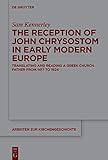The Reception of John Chrysostom in Early Modern Europe : Translating and Reading a Greek Church Father from 1417 to 1624 / Sam Kennerley.
Material type: TextSeries: Arbeiten zur Kirchengeschichte ; 157Publisher: Berlin ; Boston : De Gruyter, [2022]Copyright date: ©2023Description: 1 online resource (XI, 334 p.)Content type:
TextSeries: Arbeiten zur Kirchengeschichte ; 157Publisher: Berlin ; Boston : De Gruyter, [2022]Copyright date: ©2023Description: 1 online resource (XI, 334 p.)Content type: - 9783110708844
- 9783110708967
- 9783110708905
- online - DeGruyter
- Issued also in print.
| Item type | Current library | Call number | URL | Status | Notes | Barcode | |
|---|---|---|---|---|---|---|---|
 eBook
eBook
|
Biblioteca "Angelicum" Pont. Univ. S.Tommaso d'Aquino Nuvola online | online - DeGruyter (Browse shelf(Opens below)) | Online access | Not for loan (Accesso limitato) | Accesso per gli utenti autorizzati / Access for authorized users | (dgr)9783110708905 |
Browsing Biblioteca "Angelicum" Pont. Univ. S.Tommaso d'Aquino shelves, Shelving location: Nuvola online Close shelf browser (Hides shelf browser)
Frontmatter -- Contents -- Abbreviations -- Part 1: Introduction -- 1 Introduction -- Part 2: From late antiquity to the Italian Renaissance -- 1 The transmission and translation of Chrysostom during late antiquity the Middle Ages -- 2 Ambrogio Traversari: Translating Chrysostom in early Renaissance Florence -- 3 John Chrysostom in late Byzantine and post-Byzantine patristic scholarship -- 4 Translations of John Chrysostom in Renaissance Rome from Nicholas V (1447–1455) to Sixtus IV (1471–1484) -- 5 The first printed editions of John Chrysostom, c.1466–1504 -- Part 3: The politics of patristic scholarship in Reformation Basel: Erasmus, his friends, and their enemies -- 1 New texts, new questions, and a new interpretation of Paul -- 2 The politics of patristic scholarship in Reformation Basel -- 3 Erasmus in exile: The 1530 and 1536 Opera omnia -- 4 Erasmus’s Life of John Chrysostom -- Part 4: Patristic scholarship in an age of confessionalisation -- 1 Confessionalisation and scholarship: Setting the scene -- 2 Testing and ignoring confessionalisation in Brescia, Basel, and Paris: 1536–1547 -- 3 An Italian interlude: 1548–1554 -- 4 A rivalry renewed: The Opera omnia of 1556 (Paris), 1558 (Basel), and 1570 (Paris) -- 5 Censoring and translating Chrysostom in Italy, the Low Countries, and France, 1571–1585 -- 6 Education, collaboration, and confession: 1585–1624 -- Part 5: General conclusion -- General conclusion -- Bibliography -- Images -- Indices
restricted access online access with authorization star
http://purl.org/coar/access_right/c_16ec
The Reception of John Chrysostom in Early Modern Europe explores when, how, why, and by whom one of the most influential Fathers of the Greek Church was translated and read during a particularly significant period in the reception of his works. This was the period between the first Neo-Latin translation of Chrysostom in 1417 and the final volume of Fronton du Duc’s Greek-Latin edition in 1624, years in which readers and translators from Renaissance Italy, the Byzantine Empire, and the Basel, Paris, and Rome of a newly-confessionalised Europe found in Chrysostom everything from a guide to Latin oratory, to a model interpreter of Paul. By drawing on evidence that ranges from Greek manuscripts to conciliar acts, this book contextualises the hundreds of translations and editions of Chrysostom that were produced in Europe between 1417 and 1624, while demonstrating the lasting impact of these works on scholarship about this Church Father today.
Issued also in print.
Mode of access: Internet via World Wide Web.
In English.
Description based on online resource; title from PDF title page (publisher's Web site, viewed 02. Mai 2023)









